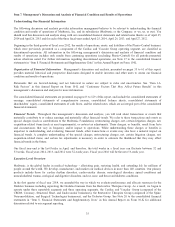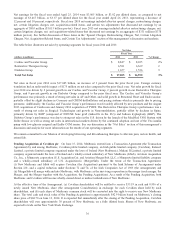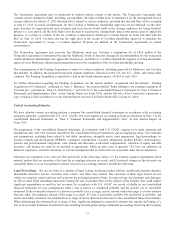Medtronic 2014 Annual Report Download - page 35
Download and view the complete annual report
Please find page 35 of the 2014 Medtronic annual report below. You can navigate through the pages in the report by either clicking on the pages listed below, or by using the keyword search tool below to find specific information within the annual report.in the health care industry, our revenues would decrease and our consolidated earnings, financial condition, and/or cash flows
would suffer.
Our business is indirectly subject to health care industry cost-containment measures that could result in reduced sales of
medical devices containing our components.
Most of our customers, and the health care providers to whom our customers supply medical devices, rely on third-party payers,
including government programs and private health insurance plans, to reimburse some or all of the cost of the procedures in
which medical devices that incorporate components we manufacture or assemble are used. The continuing efforts of
governmental authorities, insurance companies, and other payers of health care costs to contain or reduce these costs could lead
to patients being unable to obtain approval for payment from these third-party payers. If third-party payer payment approval
cannot be obtained by patients, sales of finished medical devices that include our components may decline significantly and our
customers may reduce or eliminate purchases of our components. The cost-containment measures that health care providers are
instituting, both in the U.S. and internationally, could harm our ability to operate profitably. For example, managed care
organizations have successfully negotiated volume discounts for pharmaceuticals. While this type of discount pricing does not
currently exist for medical devices, if managed care or other organizations were able to affect discount pricing for devices, it
could result in lower prices to our customers from their customers and, in turn, reduce the amounts we can charge our customers
for our medical devices.
Our research and development efforts rely upon investments and investment collaborations, and we cannot guarantee that
any previous or future investments or investment collaborations will be successful.
Our strategy to provide a broad range of therapies to restore patients to fuller, healthier lives requires a wide variety of
technologies, products, and capabilities. The rapid pace of technological development in the medical industry and the
specialized expertise required in different areas of medicine make it difficult for one company alone to develop a broad portfolio
of technological solutions. In addition to internally generated growth through our research and development efforts, historically
we have relied, and expect to continue to rely, upon investments and investment collaborations to provide us access to new
technologies both in areas served by our existing businesses as well as in new areas.
We expect to make future investments where we believe that we can stimulate the development of, or acquire, new technologies
and products to further our strategic objectives and strengthen our existing businesses. Investments and investment
collaborations in and with medical technology companies are inherently risky, and we cannot guarantee that any of our previous
or future investments or investment collaborations will be successful or will not materially adversely affect our consolidated
earnings, financial condition, and/or cash flows.
The continuing development of many of our products depends upon us maintaining strong relationships with health care
professionals.
If we fail to maintain our working relationships with health care professionals, many of our products may not be developed and
marketed in line with the needs and expectations of the professionals who use and support our products, which could cause a
decline in our earnings and profitability. The research, development, marketing, and sales of many of our new and improved
products is dependent upon our maintaining working relationships with health care professionals. We rely on these professionals
to provide us with considerable knowledge and experience regarding the development, marketing, and sale of our products.
Physicians assist us as researchers, marketing and product consultants, inventors, and public speakers. If we are unable to
maintain our strong relationships with these professionals and continue to receive their advice and input, the development and
marketing of our products could suffer, which could have a material adverse effect on our consolidated earnings, financial
condition, and/or cash flows.
Negative conditions in the global credit market may impair our commercial paper program, our auction rate securities, and
our other fixed income securities, which may cause us losses and liquidity issues.
We have investments in marketable debt securities that are classified and accounted for as available-for-sale. Our debt securities
include U.S. and foreign government and agency securities, corporate debt securities, certificates of deposit, debt funds, and
mortgage-backed and other asset-backed securities, including auction rate securities. Market conditions over the past several
years have included periods of significant economic uncertainty and at times general market distress, especially in the banking
and financial services sector. During these periods of economic uncertainty, we may experience reduced liquidity across the
fixed-income investment market, including the securities in which we invest. In the event we need to sell these securities, we
27
























